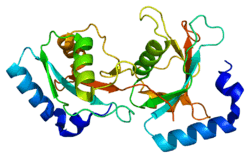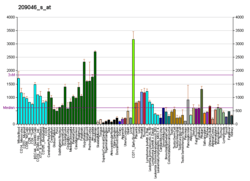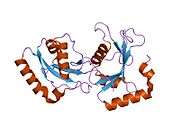GABARAPL2
Gamma-aminobutyric acid receptor-associated protein-like 2 is a protein that in humans is encoded by the GABARAPL2 gene.[5][6]
Interactions
GABARAPL2 has been shown to interact with ULK1,[7] ATG4B,[8][9] and FAM134B.[10]
gollark: He is making an OUT-OF-GAME HTTP SERVER to do something or other.
gollark: NO!
gollark: Because CC will connect to it with HTTP.
gollark: No.
gollark: <@116952546664382473>
References
- GRCh38: Ensembl release 89: ENSG00000034713 - Ensembl, May 2017
- GRCm38: Ensembl release 89: ENSMUSG00000031950 - Ensembl, May 2017
- "Human PubMed Reference:". National Center for Biotechnology Information, U.S. National Library of Medicine.
- "Mouse PubMed Reference:". National Center for Biotechnology Information, U.S. National Library of Medicine.
- Xin Y, Yu L, Chen Z, Zheng L, Fu Q, Jiang J, Zhang P, Gong R, Zhao S (Jun 2001). "Cloning, expression patterns, and chromosome localization of three human and two mouse homologues of GABA(A) receptor-associated protein". Genomics. 74 (3): 408–13. doi:10.1006/geno.2001.6555. PMID 11414770.
- "Entrez Gene: GABARAPL2 GABA(A) receptor-associated protein-like 2".
- Okazaki N, Yan J, Yuasa S, Ueno T, Kominami E, Masuho Y, Koga H, Muramatsu M (Dec 2000). "Interaction of the Unc-51-like kinase and microtubule-associated protein light chain 3 related proteins in the brain: possible role of vesicular transport in axonal elongation". Brain Research. Molecular Brain Research. 85 (1–2): 1–12. doi:10.1016/S0169-328X(00)00218-7. PMID 11146101.
- Ewing RM, Chu P, Elisma F, Li H, Taylor P, Climie S, McBroom-Cerajewski L, Robinson MD, O'Connor L, Li M, Taylor R, Dharsee M, Ho Y, Heilbut A, Moore L, Zhang S, Ornatsky O, Bukhman YV, Ethier M, Sheng Y, Vasilescu J, Abu-Farha M, Lambert JP, Duewel HS, Stewart II, Kuehl B, Hogue K, Colwill K, Gladwish K, Muskat B, Kinach R, Adams SL, Moran MF, Morin GB, Topaloglou T, Figeys D (2007). "Large-scale mapping of human protein-protein interactions by mass spectrometry". Molecular Systems Biology. 3 (1): 89. doi:10.1038/msb4100134. PMC 1847948. PMID 17353931.
- Stelzl U, Worm U, Lalowski M, Haenig C, Brembeck FH, Goehler H, Stroedicke M, Zenkner M, Schoenherr A, Koeppen S, Timm J, Mintzlaff S, Abraham C, Bock N, Kietzmann S, Goedde A, Toksöz E, Droege A, Krobitsch S, Korn B, Birchmeier W, Lehrach H, Wanker EE (Sep 2005). "A human protein-protein interaction network: a resource for annotating the proteome". Cell. 122 (6): 957–68. doi:10.1016/j.cell.2005.08.029. hdl:11858/00-001M-0000-0010-8592-0. PMID 16169070.
- Khaminets, Aliaksandr; Heinrich, Theresa; Mari, Muriel; Grumati, Paolo; Huebner, Antje K.; Akutsu, Masato; Liebmann, Lutz; Stolz, Alexandra; Nietzsche, Sandor (2015-06-18). "Regulation of endoplasmic reticulum turnover by selective autophagy". Nature. 522 (7556): 354–358. doi:10.1038/nature14498. ISSN 0028-0836. PMID 26040720.
Further reading
- Rohwer A, Kittstein W, Marks F, Gschwendt M (Jul 1999). "Cloning, expression and characterization of an A6-related protein". European Journal of Biochemistry / FEBS. 263 (2): 518–25. doi:10.1046/j.1432-1327.1999.00537.x. PMID 10406962.
- Sagiv Y, Legesse-Miller A, Porat A, Elazar Z (Apr 2000). "GATE-16, a membrane transport modulator, interacts with NSF and the Golgi v-SNARE GOS-28". The EMBO Journal. 19 (7): 1494–504. doi:10.1093/emboj/19.7.1494. PMC 310219. PMID 10747018.
- Hartley JL, Temple GF, Brasch MA (Nov 2000). "DNA cloning using in vitro site-specific recombination". Genome Research. 10 (11): 1788–95. doi:10.1101/gr.143000. PMC 310948. PMID 11076863.
- Okazaki N, Yan J, Yuasa S, Ueno T, Kominami E, Masuho Y, Koga H, Muramatsu M (Dec 2000). "Interaction of the Unc-51-like kinase and microtubule-associated protein light chain 3 related proteins in the brain: possible role of vesicular transport in axonal elongation". Brain Research. Molecular Brain Research. 85 (1–2): 1–12. doi:10.1016/S0169-328X(00)00218-7. PMID 11146101.
- Simpson JC, Wellenreuther R, Poustka A, Pepperkok R, Wiemann S (Sep 2000). "Systematic subcellular localization of novel proteins identified by large-scale cDNA sequencing". EMBO Reports. 1 (3): 287–92. doi:10.1093/embo-reports/kvd058. PMC 1083732. PMID 11256614.
- Tanida I, Tanida-Miyake E, Nishitani T, Komatsu M, Yamazaki H, Ueno T, Kominami E (Mar 2002). "Murine Apg12p has a substrate preference for murine Apg7p over three Apg8p homologs". Biochemical and Biophysical Research Communications. 292 (1): 256–62. doi:10.1006/bbrc.2002.6645. PMID 11890701.
- Scherz-Shouval R, Sagiv Y, Shorer H, Elazar Z (Apr 2003). "The COOH terminus of GATE-16, an intra-Golgi transport modulator, is cleaved by the human cysteine protease HsApg4A". The Journal of Biological Chemistry. 278 (16): 14053–8. doi:10.1074/jbc.M212108200. PMID 12473658.
- Wiemann S, Arlt D, Huber W, Wellenreuther R, Schleeger S, Mehrle A, Bechtel S, Sauermann M, Korf U, Pepperkok R, Sültmann H, Poustka A (Oct 2004). "From ORFeome to biology: a functional genomics pipeline". Genome Research. 14 (10B): 2136–44. doi:10.1101/gr.2576704. PMC 528930. PMID 15489336.
- Rual JF, Venkatesan K, Hao T, Hirozane-Kishikawa T, Dricot A, Li N, Berriz GF, Gibbons FD, Dreze M, Ayivi-Guedehoussou N, Klitgord N, Simon C, Boxem M, Milstein S, Rosenberg J, Goldberg DS, Zhang LV, Wong SL, Franklin G, Li S, Albala JS, Lim J, Fraughton C, Llamosas E, Cevik S, Bex C, Lamesch P, Sikorski RS, Vandenhaute J, Zoghbi HY, Smolyar A, Bosak S, Sequerra R, Doucette-Stamm L, Cusick ME, Hill DE, Roth FP, Vidal M (Oct 2005). "Towards a proteome-scale map of the human protein-protein interaction network". Nature. 437 (7062): 1173–8. doi:10.1038/nature04209. PMID 16189514.
- Sou YS, Tanida I, Komatsu M, Ueno T, Kominami E (Feb 2006). "Phosphatidylserine in addition to phosphatidylethanolamine is an in vitro target of the mammalian Atg8 modifiers, LC3, GABARAP, and GATE-16". The Journal of Biological Chemistry. 281 (6): 3017–24. doi:10.1074/jbc.M505888200. PMID 16303767.
- Mehrle A, Rosenfelder H, Schupp I, del Val C, Arlt D, Hahne F, Bechtel S, Simpson J, Hofmann O, Hide W, Glatting KH, Huber W, Pepperkok R, Poustka A, Wiemann S (Jan 2006). "The LIFEdb database in 2006". Nucleic Acids Research. 34 (Database issue): D415-8. doi:10.1093/nar/gkj139. PMC 1347501. PMID 16381901.
- Ewing RM, Chu P, Elisma F, Li H, Taylor P, Climie S, McBroom-Cerajewski L, Robinson MD, O'Connor L, Li M, Taylor R, Dharsee M, Ho Y, Heilbut A, Moore L, Zhang S, Ornatsky O, Bukhman YV, Ethier M, Sheng Y, Vasilescu J, Abu-Farha M, Lambert JP, Duewel HS, Stewart II, Kuehl B, Hogue K, Colwill K, Gladwish K, Muskat B, Kinach R, Adams SL, Moran MF, Morin GB, Topaloglou T, Figeys D (2007). "Large-scale mapping of human protein-protein interactions by mass spectrometry". Molecular Systems Biology. 3 (1): 89. doi:10.1038/msb4100134. PMC 1847948. PMID 17353931.
This article is issued from Wikipedia. The text is licensed under Creative Commons - Attribution - Sharealike. Additional terms may apply for the media files.






